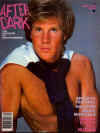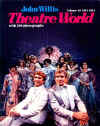Our Love Is Here To Stay VII
Stonewall & After
by John Kenrick
(Copyright 1996, last revised 2008)
(All the images below are thumbnails – click on them to see larger versions.)
Stonewall
New York City began June 27th, 1969 with Judy Garland's funeral and ended it with an event that many consider (with debatable accuracy) to be the birth of the Gay Liberation movement. At 1:20 A.M., a routine police raid of New York's Stonewall Inn – a mafia owned bar that catered to gay men – turned into a riot that lasted on and off for several days. After years of accepting police oppression, gay men were finally angry enough to fight back. Some drag queens being led into a paddy wagon set the crowd off, and the rest (in widely varying versions) is history.
In the wake of what became known as the Stonewall rebellion, new and increasingly militant organizations demanded the public recognition of gay and lesbian civil rights. One year to the day after the Stonewall raid, thousands took part in the first gay pride marches in New York and Los Angeles. Through the 1970s an increasing number of homosexuals opted to be "out, loud and proud," taking to the streets and airwaves to challenge oppressive laws and bring down social barriers.
Musical Queers
The musical stage reflected these advances. The same year as the riots, Rene Auberjonois played Sebastian Baye in Coco (1969) -- this was the first openly gay character in a Broadway musical, even if it was written as a hateful caricature. A year later in the Tony Award-winning Applause (1970), Lee Roy Reams played the hairdresser Duane, the first likeable openly gay character in a Broadway musical. Applause also included a scene in a gay bar. A few years later, Tommy Tune won his first Tony portraying a blatantly gay choreographer in Seesaw (1973). A Chorus Line (1974) was the first major Broadway book musical to let gay characters discuss (in both dialogue and song) the sexual aspects of their lives.
Most of the gay plays and films of the 1970s and early 80s were presented off-off-Broadway, well outside of the mainstream. Many of these works concentrated on gay self-hatred, the search for sexual fulfillment, and flights of humorous fantasy. Many of these scripts were shallow and "of the moment," but this was to be expected in the heady years of newfound freedom.
The first musical written by and for gays to receive mainstream attention was Off-Broadway's Boy Meets Boy (1975). This charming hit by Solly & Ward imagined what the 1930s might have been like if gay and straight lifestyles were equally accepted, allowing two men to have an Astaire & Rogers-style romance. Off-Broadway's Gulp! (1977), which took a musical comedy look at the trials and tribulations of a gay lifeguard, was co-authored and produced by John Glines – the same gay impresario who later brought Harvey Fierstein's Torch Song Trilogy (1982) and William Hoffman's As Is (1985) to Broadway.
Changing Roles
 Gay Broadway star Bill Hutton
made the cover of After Dark in 1982 with this provocative
shot.
Gay Broadway star Bill Hutton
made the cover of After Dark in 1982 with this provocative
shot.
During those years, After Dark broke ground as a glossy performing arts magazine aimed at a gay audience. The Broadway opening of Joseph and The Amazing Technicolor Dreamcoat in 1982 brought the cover shown here featuring humpy leading man Bill Hutton. Similar beefcake photo spreads of officially straight actors John Travolta, Tony Danza, Treat Williams and Gregory Harrison shared After Dark's pages with features covering gay fashion and the arts.
The old backstage balance of straight producers tolerating gay performers had long since come to an end. Gays now had a firm presence in every level of management and production. One of the chorus girls from the hit revue Sugar Babies (1979) put it this way –
"My grandmother always told me when I went into the business to beware of the casting couch. I realized six months into the road (pre-Broadway tour) on this show that the girls didn't have to worry about it; it was the guys who had a problem."
- Terpsie Toon, as quoted by Dennis McGovern and Deborah Grace Winer in Sing Out, Louise!: 250 Stars of the Musical Theatre Remember 50 Years on Broadway (New York: Schirmer Books, 1993), p. 24.
The liberation of the 1970s brought on a backlash. So-called Christians tried to justify their personal bigotry by misinterpreting scripture and organizing into anti-gay activist groups that sought to outlaw gay civil rights. Rev. Jerry Falwell's self-entitled "Moral Majority" and former beauty queen Anita Bryant won several battles, but their only lasting accomplishment was to solidify the gay and lesbian community's resolve to organize and fight back.
The 1980s: "We Are What We Are"
Charles Strouse and Alan Jay Lerner's Dance a Little Closer (1983) created the first romantic homosexual couple in a Broadway musical. Two supporting male characters (portrayed by Brent Barrett and Jeff Keller) sang "Why Can't the World Leave Us Alone" and even exchanged marriage vows. You knew the world had changed when the composer of Annie and the lyricist of My Fair Lady (both of whom were heterosexual) gave Broadway its first gay love duet! Sad to say, the show had little else to offer and closed on its opening night.
 George Hearn,
Gene Barry and the original Cagelles from Jerry
Herman's La Cage Aux Folles. Appearing on the cover of the Theatre World annual
remains a singular honor reserved for shows that define their season.
George Hearn,
Gene Barry and the original Cagelles from Jerry
Herman's La Cage Aux Folles. Appearing on the cover of the Theatre World annual
remains a singular honor reserved for shows that define their season.
Broadway's first gay-themed musical hit appeared a few months later – Jerry Herman & Harvey Fierstein's acclaimed adaptation of La Cage Aux Folles (1983). Blue haired ladies who would never have gone to "gay theatre" cheered for the story of a middle-aged gay couple struggling with homophobic in-laws, and for the defiant gay anthem "I Am What I Am." It was a breakthrough moment, and a damned entertaining one too.
Just when gays and lesbians were claiming an open place in society, something awful started happening. Gay men – including a terrifying number of actors, directors, designers, writers and theatergoers – were getting horrifically sick and dying, sometimes in a matter of days or weeks. Nicknamed "the gay plague," this appalling disease was dubbed "Acquired Immune Deficiency Syndrome" in 1982. AIDS would change both the gay community and the musical theatre in ways no one could have imagined.
